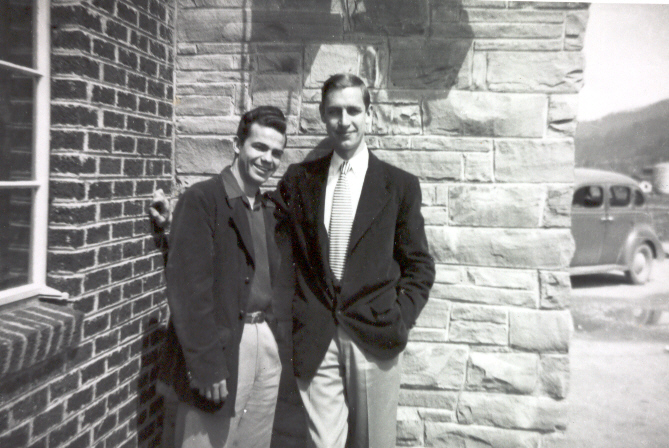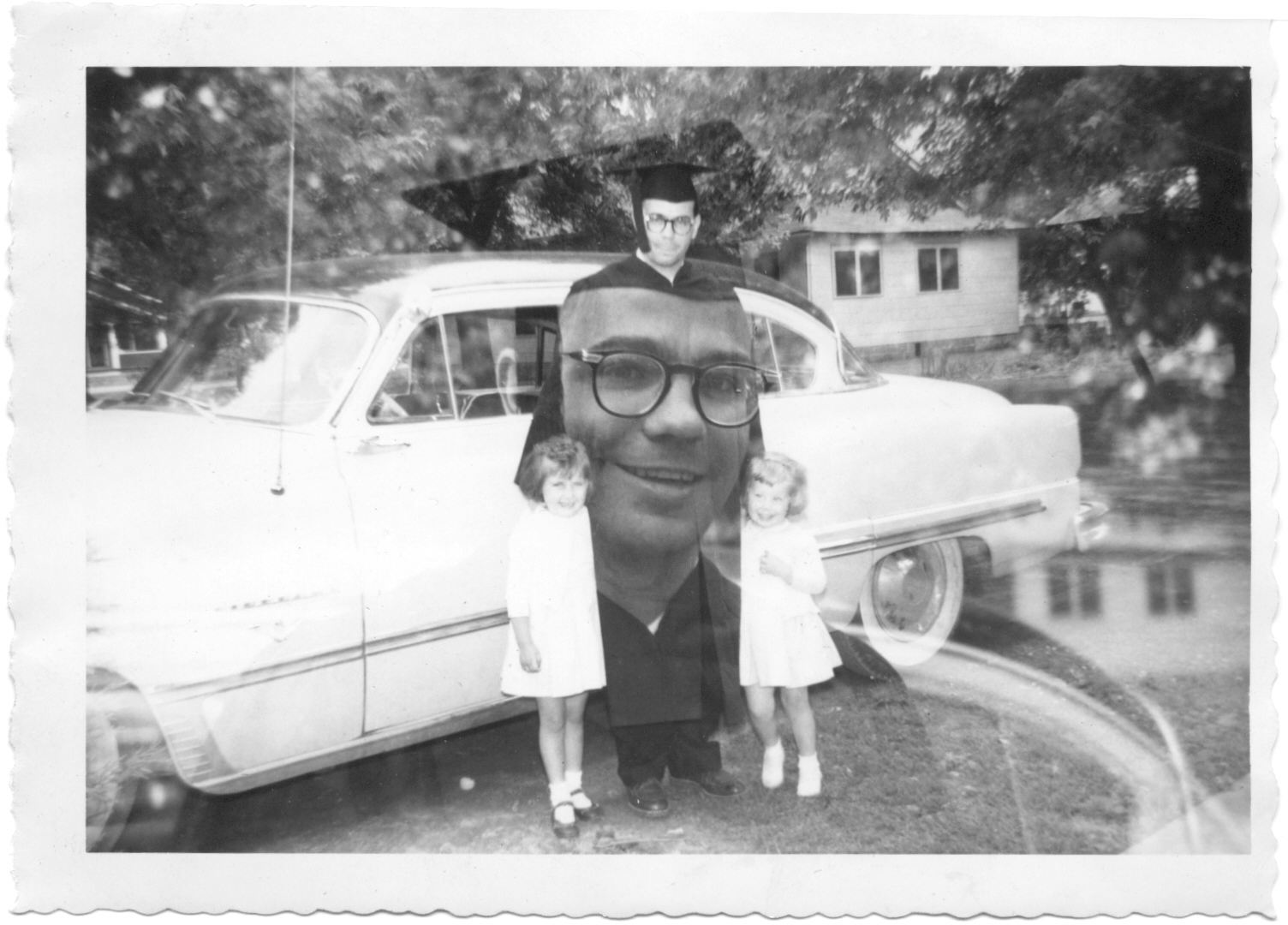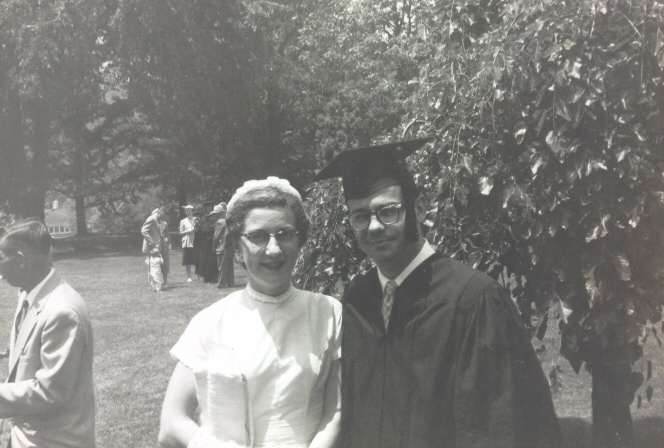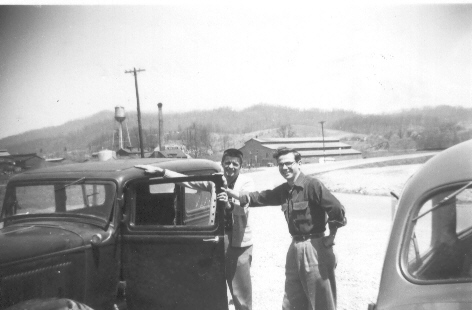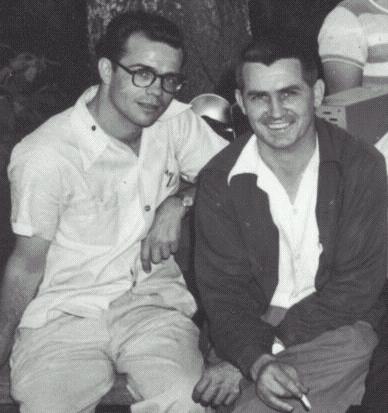
Below is Tal England and Bill Baker.
A Biography of Talmadge Ray England
I was born December 22, 1929 during the depression that still affects many families today, especially in the South. My mother and father were not educated past the sixth or seventh grade. They worked hard when they could find work at all. My father was killed in an accident during my third year.
In those days, there was essentially no welfare and people depended on one another for minimal support. We had very little, but I wasn't unhappy. There were people around who loved me, my grandfather in particular. We lived where I was born, in Bonham, Texas, until I was ten. Then my mother remarried and we moved to Little Rock, Arkansas.
I started the 5th grade in Little Rock. I was very good at Art, and won
the state art contest. The picture I painted hung in the state capitol for many years. I also painted murals on the cafeteria walls during the 5th grade, and these remained there at least ten years. I didn't pursue art much longer.
When I was fourteen we moved to Wyoming. About three months later my stepfather asked me to leave after a minor incident. I went to live with my grandparents who then lived in Waurika, Oklahoma. There I completed the 9th grade, my last in public school.
By then, my mother, half-brother, and brother (three years younger than me), and stepfather were living in Claiborne, Texas. They asked me to return. I did, and shortly after that (a month or so), my stepfather left. (I later learned that he was killed in an accident on his way to California.) This left us in a very bad situation. I worked at simple jobs, found by family members, and helped get mother and my brothers back to Arkansas.
At fifteen I had no place to live and no possibility of continuing in school. That was the summer of 1945. The war with Germany was still on, but nearly over. The war with Japan was tooling up in earnest. I joined the Navy. (In photos, it is obvious that I wasn't of age to join, but I suppose the country was desperate.)
This was the best thing that ever happened to me in terms of future
employment. The war with Germany ended about a month after I joined,
and while I was in boot camp, the atomic bomb was dropped ending the
war with Japan.
I was sent to Guam where I stayed six or seven months, working as an electrician. My grandfather contacted Sam Raburne, speaker of the house, insisting that I was too young to be in the navy; so I was discharged in 1946.
I used the GI Bill to attend a radio school in Little Rock where I passed exams for the radiotelephone, radiotelegraph, and GED. The Radiotelephone license was necessary for work in commercial radio, such as WMIK. Electronics was a true love for me.
My first job was with WGRV in Greenville, Tennessee. I don't remember exactly how I found the job from Little Rock. That job started in May of 1947. I also worked at a sister station in Elizabethton, Tennessee, WBEG. Later I had the opportunity to help build the station in Morristown, Tennessee, WCRK. This was very good experience, and the job included some announcing.
Following the experience with WCRK, I was offered another chance to help install the equipment for WUSN, in Charleston, South Carolina. This was completed in May of 1948. The manager was a former vice-president of CBS. He got a job offer for me with CBS radio.
By this time, I realized I really needed more education, and used the remainder of the GI Bill to attend Capitol Radio Engineering Institute (CREI) in Washington, D.C. This was an extensive course, and I did very well. I think I was second in my class.
During the time in Washington, I met my future wife, Carol Odell. We met in the Fall of 1948 and married in March 1949 when Carol was eighteen by four days, and I was nineteen by three months. We have been married ever since, and that was the second great thing that happened in my life.
I had graduated from CREI, and took a job as chief engineer at a station
being constructed in Orange, Virginia, WBEJ. That was a good experience, but I also made a huge mistake. In a dispute with the station manager, I
quit without having any idea of what I would do. I ended up living with
Carol's family for three months in Middletown, New York.
I don't remember exactly how I was hired as Chief Engineer of WMIK, starting in April of 1950. That was a very fortunate position for me. I worked at WMIK for six and a half years. My two oldest daughters were born in Middlesboro.
I was permitted to enroll on probation at Lincoln Memorial University (in part based on the GED). I graduated in 1956 with a GPA of 2.86 on the 3 point system, or 3.86 on the more common four point system. Finally, I had erased missing three years of high school!
We left Middlesboro in October 1956, and moved to Pittsburgh to work for Westinghouse at the Bettis Atomic Power Laboratory. The laboratory developed atomic power for the navy’s nuclear submarine, The Nautilus, and the first atomic power station. I wasn't especially interested in atomic power; it was less interesting than electronics. But I was inclined to develop new methods for analytical methods, and did well. Some of the things I developed in 1956-60 are still being used. I worked on the design of the world’s first nuclear power station at Shippingport and the first super submarine.
My third daughter was born in 1960. That was a year I had a very serious illness and had to stop graduate school where I was majoring in physics. I actually continued for two years at the University of Pittsburgh, turning in some research for the Ph.D. as a Masters degree. I was attending graduate school under a joint Westinghouse-Atomic Energy Commission (AEC) fellowship.
Because my work at Westinghouse had become well known, the University of Wisconsin asked me to join their graduate department in Nuclear Engineering as a visiting professor for a year. I agreed to provide lectures on two subjects for five days, and they accepted.
While there, they asked if I would stay another year, but I said that if I was in graduate school, I would rather finish the Ph.D. They agreed. They also agreed to pay moving expenses and provide a traineeship for two years.
I jumped on this, and worked very hard to finish what I had started at the University of Pittsburgh. (My fourth daughter, Rhonda, had been born in 1966 just before leaving Pittsburgh.) I finished the Ph.D. in September of 1969, and returned to Westinghouse for three years. I didn't look for any other position, but my work with Westinghouse turned out to be well known. My thesis was also known and used, in part, to break the old AEC into two parts, which includes the current Nuclear Regulatory Commission (NRC). In 1971 I was asked to join the Theoretical Division at the Los Alamos National Laboratory (LANL). To me, that was an honor, and I joined in 1972.
Since then, I have worked in the theoretical group on nuclear data. My work there was also well known, and many people around the world came to
work with me. I have published about 200 papers, and have been invited to talk in international and national meetings.
I decided to retire at the end of 1990, but continued to work essentially
full time through 1995 as an associate scientist, and since then in the same
position as a consultant.
I realize that my biography leaves many questions unanswered about why and how. But I have read other biographies and find the details too much to handle.
I hope that students and anyone else who takes the time to read it will realize that I have worked hard, had much luck, and must have been very determined in order to reach the such status without family assistance, and after missing three years of high school. I never wanted to quit school, and didn't deliberately. I simply had no place to live in 1945 at the age of fifteen.
There are many good people in the world who recognize honesty and
determination. I was fortunate to meet many.
My resume provides a fairly complete summary of my actual accomplishments.
Talmadge England
July 2001
Talmadge R. England-Resume--1995
EDUCATION: Ph.D. Nuclear Engineering, Physics minor, U. of Wisconsin, 1969; MS Physics, math minor, U. of Pittsburgh, 1962; BS Physics, math, Lincoln Memorial U. 1956
MILITARY; US Navy 1945-1946
PROFESSIONAL EXPERIENCE; 12/72--present
Staff member Theoretical Division, Nuclear Theory Applications Group (T-2), Los Alamos National Laboratory, Los Alamos, NM (Assoc. Staff Member, 2/91, same group)
1956—72: Junior/senior scientist in physics groups for analysis and methods development at the Westinghouse Bettis Atomic Power Laboratory, Pittsburgh, Pa. Primary work for three Projects: Shippingport (first commercial reactor), Light Water Breeder (first LWBR reactor), and Advanced Submarine Reactor (on leave of absence, U. of Wisconsin, 1967-69).
HONORS/AWARDS; Class Salutatorian 1956; Three minor awards as Best Student in Mathematics,
Physics, and English Composition; Joint US AEC-Westinghouse Fellowship for graduate studies in
Physics, 1956-62; Bettis Atomic Power Laboratory's nomination for Lamme Fellowship, 1965; AEC Traineeship U. of Wisconsin, 1967-69; Marquis Who's Who, 1986--current(?); SOCIETIES (CURRENT MEMBERSHIP); American Nuclear Society (ANS) (Emeritus); Institute of Electrical and Electronic Engineers (IEEE) (life member); American Association for the Advancement of Science (AAAS) (Emeritus); Sigma Chi (Emeritus)
NATIONAL and INTERNATIONAL COMMITTEES; Two year appointment to National US DOE; Committee to Define US; Nuclear Data Needs; US Evaluated Nuclear Data base (ENDF), maintained at
Brookhaven National Laboratory: 1) Member of Cross Section Evaluation Group (CSEWG); 2) Chairman Fission Product Yields Subcommittee of CSEWG.; 3) Chairman of Yields and Decay Data Subcommittee (in 1989, the decay data was added to the yields subcommittee) 4) International Committee Group 6 for Delayed Neutron Data, CEN, Saclay, France [US member appointed 1989 when six international groups were formed for global evaluations]
American Nuclear Society Committees: 1) Member Physics Data Standards, ANS19; 2) Secretary of standard for Decay Power Working Group, ANS5.1; 3) Chairman Fission Product Yields Standard Working Group, ANS19.8; 4) Member Delayed Neutron Parameters Working Group, ANS19.9
(Chairman, 1989-1992)
International Atomic Energy Agency, Vienna, Austria (IAEA), Chief of US Research of Coordinated Research Committee for ``Fission Product Yields Evaluation Methods and Data."
PUBLICATIONS: Approximately 200 to 1995, most being related to nuclear data theory,
evaluations and applications; most were invited papers at various national and international meetings.
SOME SIGNIFICANT ACHIEVEMENTS
* Developed theory of power spatial oscillations in nuclear reactors.
* Designed first nuclear quadrupole resonance spectrometer to operate at
UHF frequencies.
* Developed theory and corresponding computer code to describe nuclide
generation and transmutation in nuclear reactors and accelerators.
* Published first predictions of parasitic absorption and decay power in
nuclear reactors based on nuclide data. (Developed the CINDER computer
code which is still used as the industry standard since 1960.)
* Provided first content in temporal radioactive fallout from fission pulses.
* Predicted beta spectra trapped in earth's magnetic field for USAF.
* Provided Presidential Commission on Three Mile Island Accident with
calculations of radioactive materials content, and also provided similar
information to US NRC for the Chernobyl accident in Russia.
* Produced first direct theoretical calculations of delayed neutron values
and spectra (now included in US evaluated nuclear data files).
* US Strategic Defense Initiative (SDI): provided all decay spectra from pulse
fission for use in designs. (Popularly known as "star wars")
* Provided first theoretical calculations of photoneutron production (needed
in reactor startup for nuclear submarines).
* Evaluation of decay data and fission product yields, including aggregate
delayed neutron data, for the US Data Base has required nearly a decade
(completed in 1994): this effort has received global recognition,
resulting in continuing national and international collaborations. It is a
major personal achievement.
Graduation and an unusual double image; Tal and daughters.
Graduation day at LMU with wife, Carol
Bronell Reedy and Tal at the station
Here's Tal and Hubert Turner at a Ham radio
field day around 1952.
